Report on Managing Food and Beverage Operations: Trends and Strategies
VerifiedAdded on 2021/02/18
|13
|3458
|95
Report
AI Summary
This report delves into the multifaceted world of food and beverage operations. It begins with an overview of the industry, encompassing various sectors like entertainment, accommodation, and food services. The report examines different rating systems used globally and analyzes present and future trends, such as technological advancements and the increasing emphasis on health and wellness. The report further explores the essential professional skills required in managing food and beverage departments, emphasizing customer service, organizational abilities, and legal compliance. It then discusses the importance of meeting regulatory requirements, including food safety, labeling policies, and import regulations, and the implications of non-compliance. The report also compares different marketing and operational technologies, like online ordering and social media, and their impact on the industry. Finally, the report investigates the factors influencing consumer decisions when choosing a food and beverage outlet, including external environment, affordability, and brand loyalty, providing a comprehensive analysis of the industry's dynamics and consumer behavior.
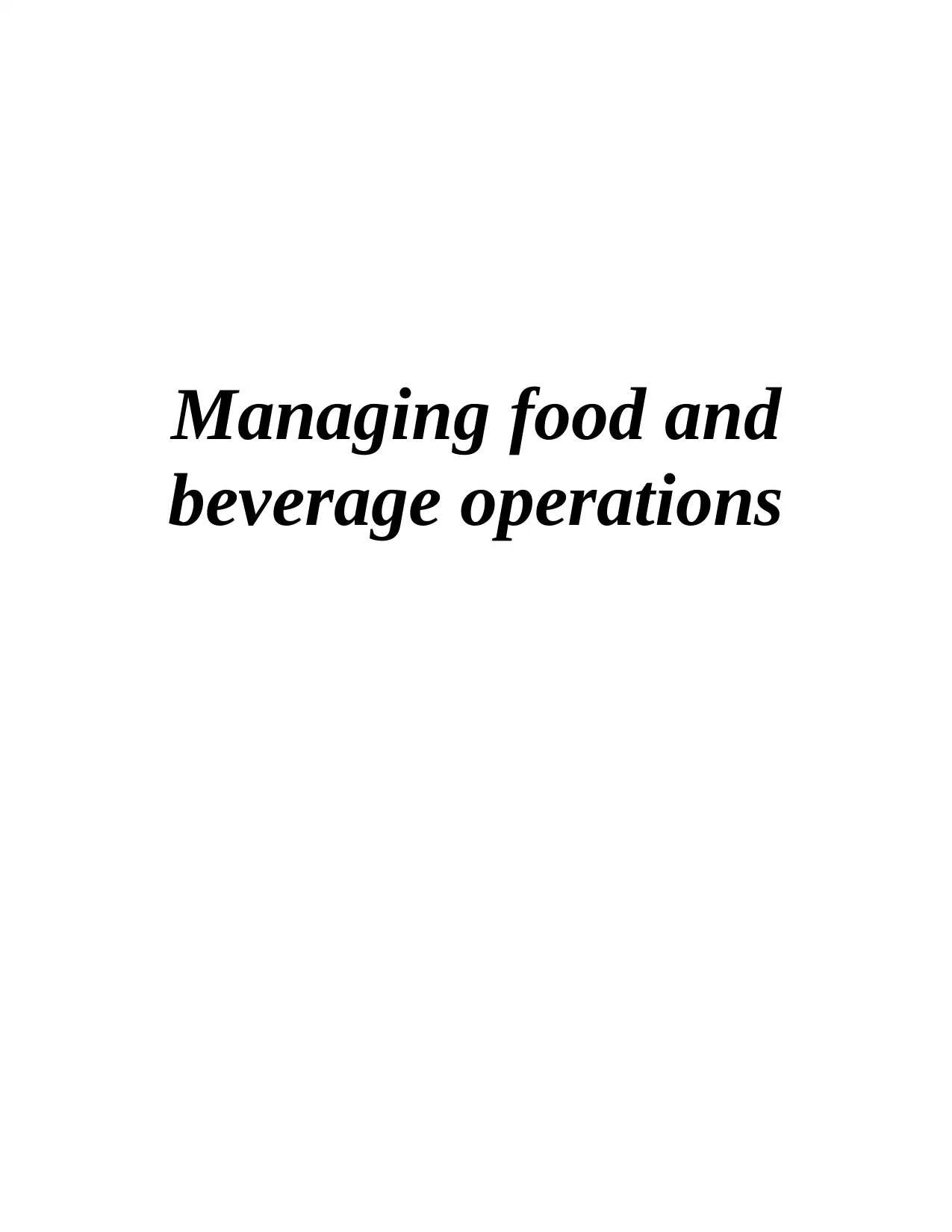
Managing food and
beverage operations
beverage operations
Paraphrase This Document
Need a fresh take? Get an instant paraphrase of this document with our AI Paraphraser
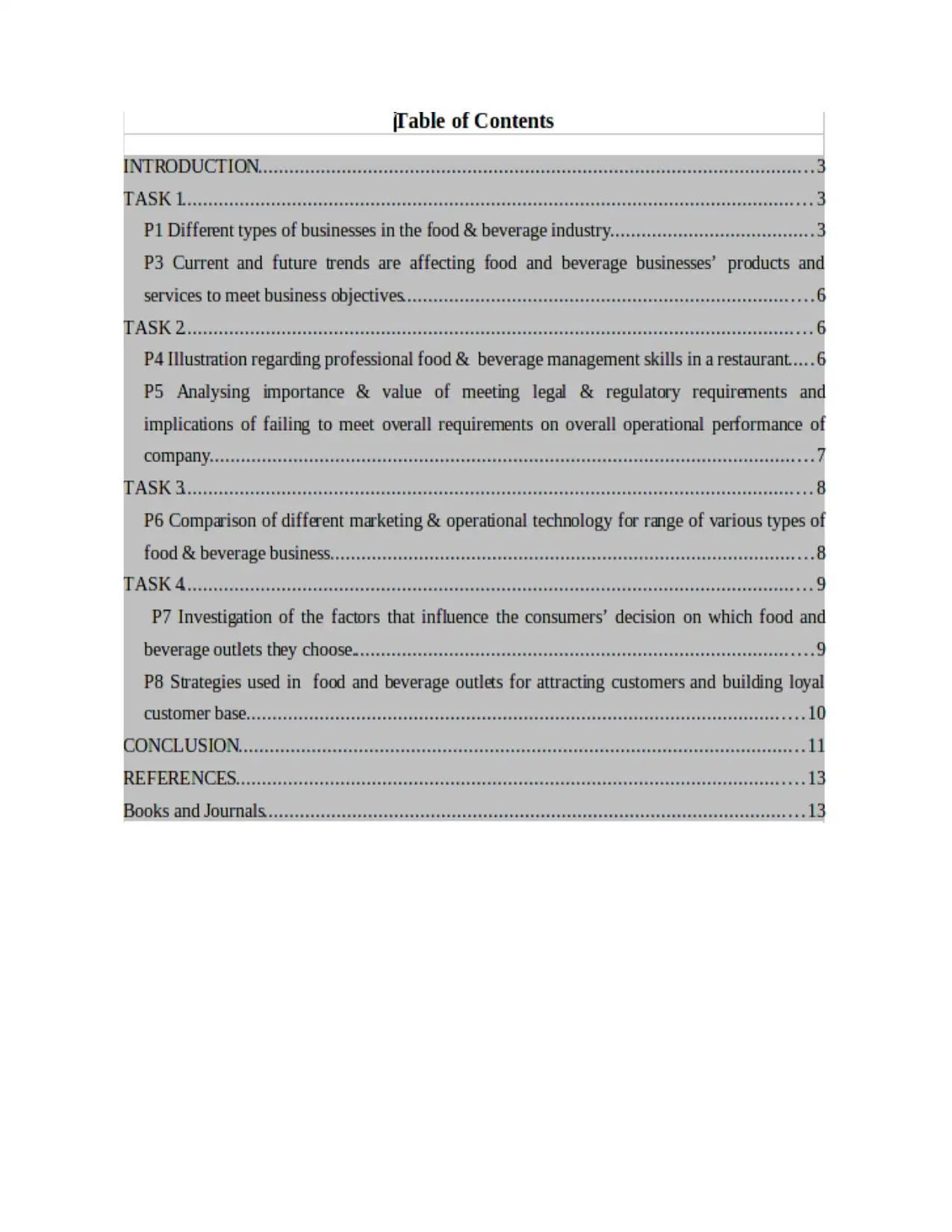
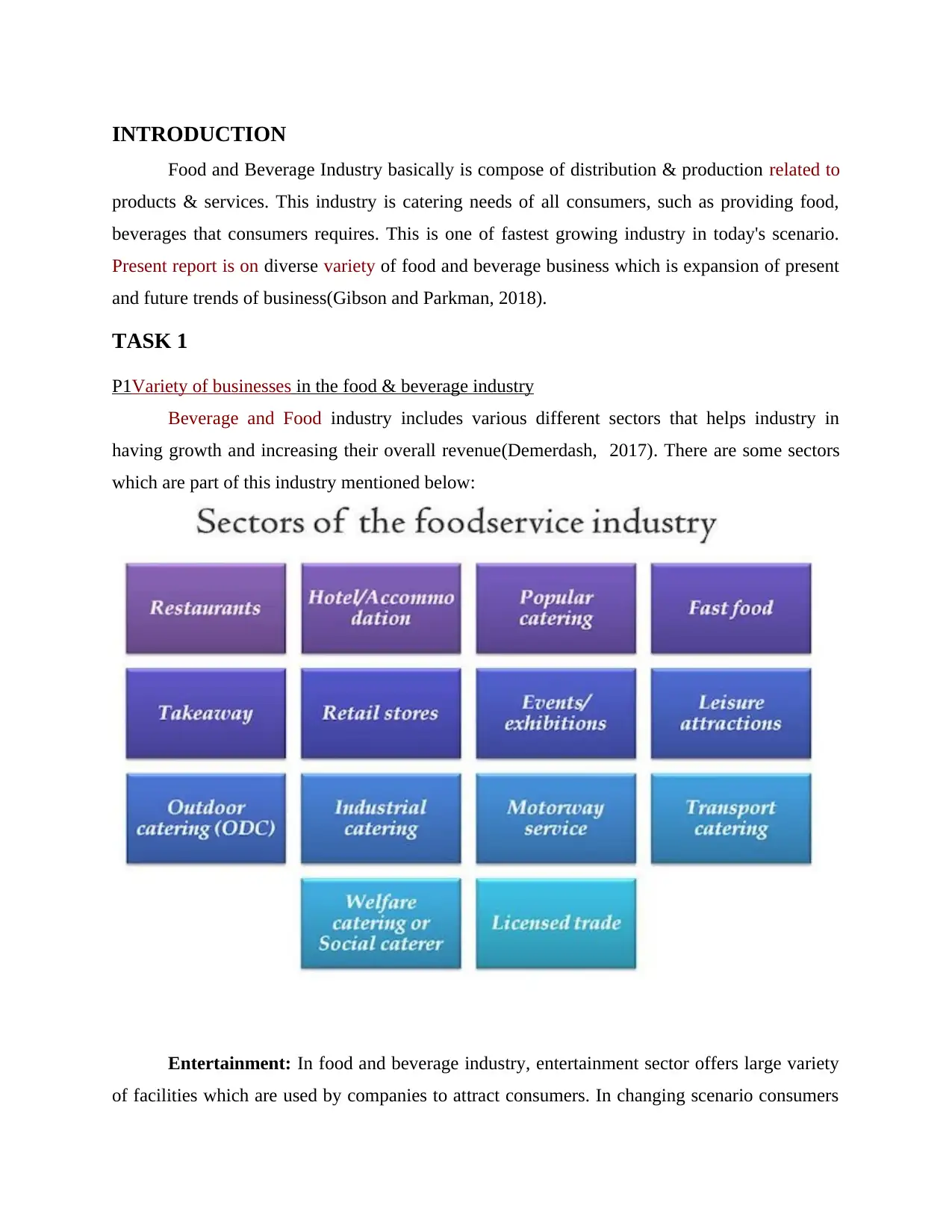
INTRODUCTION
Food and Beverage Industry basically is compose of distribution & production related to
products & services. This industry is catering needs of all consumers, such as providing food,
beverages that consumers requires. This is one of fastest growing industry in today's scenario.
Present report is on diverse variety of food and beverage business which is expansion of present
and future trends of business(Gibson and Parkman, 2018).
TASK 1
P1Variety of businesses in the food & beverage industry
Beverage and Food industry includes various different sectors that helps industry in
having growth and increasing their overall revenue(Demerdash, 2017). There are some sectors
which are part of this industry mentioned below:
Entertainment: In food and beverage industry, entertainment sector offers large variety
of facilities which are used by companies to attract consumers. In changing scenario consumers
Food and Beverage Industry basically is compose of distribution & production related to
products & services. This industry is catering needs of all consumers, such as providing food,
beverages that consumers requires. This is one of fastest growing industry in today's scenario.
Present report is on diverse variety of food and beverage business which is expansion of present
and future trends of business(Gibson and Parkman, 2018).
TASK 1
P1Variety of businesses in the food & beverage industry
Beverage and Food industry includes various different sectors that helps industry in
having growth and increasing their overall revenue(Demerdash, 2017). There are some sectors
which are part of this industry mentioned below:
Entertainment: In food and beverage industry, entertainment sector offers large variety
of facilities which are used by companies to attract consumers. In changing scenario consumers
⊘ This is a preview!⊘
Do you want full access?
Subscribe today to unlock all pages.

Trusted by 1+ million students worldwide
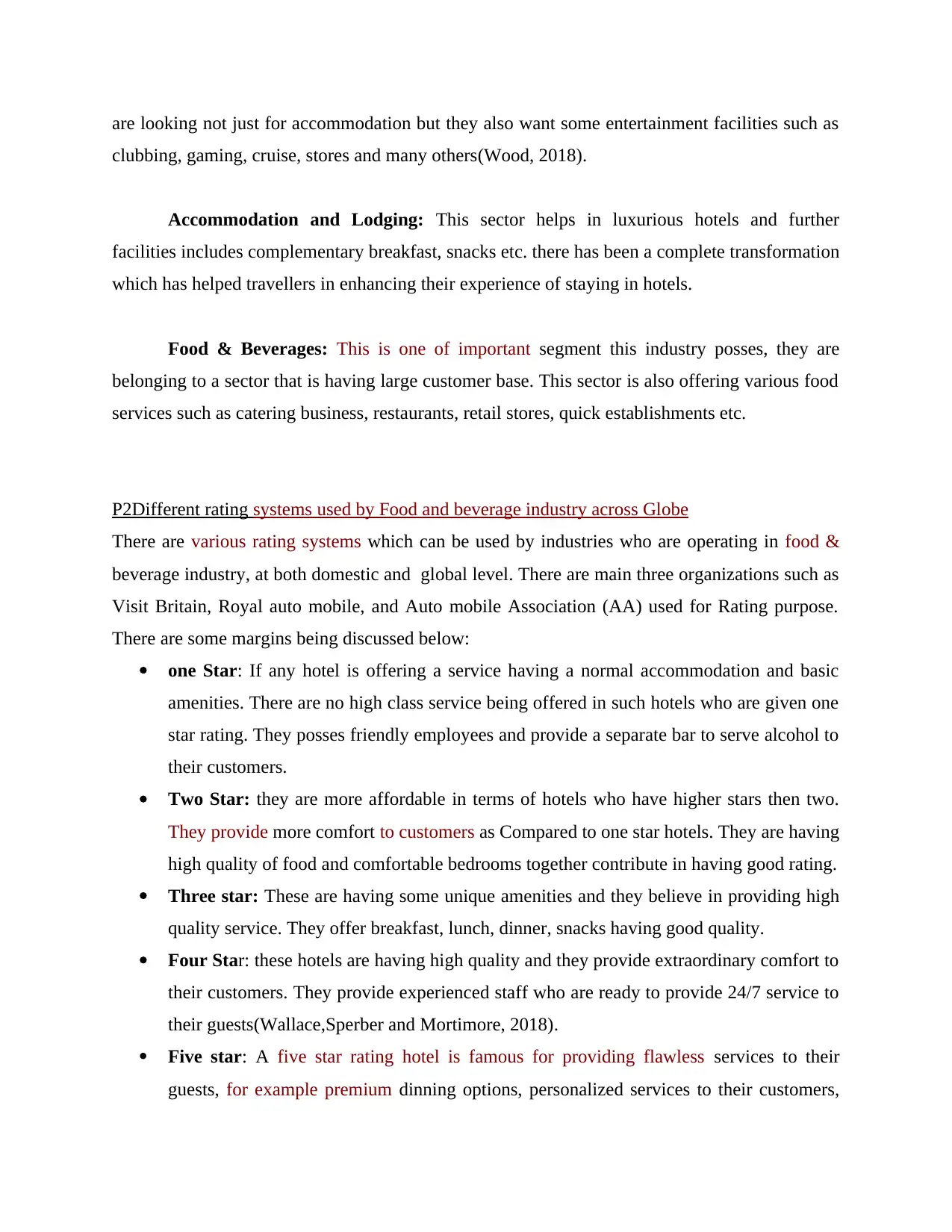
are looking not just for accommodation but they also want some entertainment facilities such as
clubbing, gaming, cruise, stores and many others(Wood, 2018).
Accommodation and Lodging: This sector helps in luxurious hotels and further
facilities includes complementary breakfast, snacks etc. there has been a complete transformation
which has helped travellers in enhancing their experience of staying in hotels.
Food & Beverages: This is one of important segment this industry posses, they are
belonging to a sector that is having large customer base. This sector is also offering various food
services such as catering business, restaurants, retail stores, quick establishments etc.
P2Different rating systems used by Food and beverage industry across Globe
There are various rating systems which can be used by industries who are operating in food &
beverage industry, at both domestic and global level. There are main three organizations such as
Visit Britain, Royal auto mobile, and Auto mobile Association (AA) used for Rating purpose.
There are some margins being discussed below:
one Star: If any hotel is offering a service having a normal accommodation and basic
amenities. There are no high class service being offered in such hotels who are given one
star rating. They posses friendly employees and provide a separate bar to serve alcohol to
their customers.
Two Star: they are more affordable in terms of hotels who have higher stars then two.
They provide more comfort to customers as Compared to one star hotels. They are having
high quality of food and comfortable bedrooms together contribute in having good rating.
Three star: These are having some unique amenities and they believe in providing high
quality service. They offer breakfast, lunch, dinner, snacks having good quality.
Four Star: these hotels are having high quality and they provide extraordinary comfort to
their customers. They provide experienced staff who are ready to provide 24/7 service to
their guests(Wallace,Sperber and Mortimore, 2018).
Five star: A five star rating hotel is famous for providing flawless services to their
guests, for example premium dinning options, personalized services to their customers,
clubbing, gaming, cruise, stores and many others(Wood, 2018).
Accommodation and Lodging: This sector helps in luxurious hotels and further
facilities includes complementary breakfast, snacks etc. there has been a complete transformation
which has helped travellers in enhancing their experience of staying in hotels.
Food & Beverages: This is one of important segment this industry posses, they are
belonging to a sector that is having large customer base. This sector is also offering various food
services such as catering business, restaurants, retail stores, quick establishments etc.
P2Different rating systems used by Food and beverage industry across Globe
There are various rating systems which can be used by industries who are operating in food &
beverage industry, at both domestic and global level. There are main three organizations such as
Visit Britain, Royal auto mobile, and Auto mobile Association (AA) used for Rating purpose.
There are some margins being discussed below:
one Star: If any hotel is offering a service having a normal accommodation and basic
amenities. There are no high class service being offered in such hotels who are given one
star rating. They posses friendly employees and provide a separate bar to serve alcohol to
their customers.
Two Star: they are more affordable in terms of hotels who have higher stars then two.
They provide more comfort to customers as Compared to one star hotels. They are having
high quality of food and comfortable bedrooms together contribute in having good rating.
Three star: These are having some unique amenities and they believe in providing high
quality service. They offer breakfast, lunch, dinner, snacks having good quality.
Four Star: these hotels are having high quality and they provide extraordinary comfort to
their customers. They provide experienced staff who are ready to provide 24/7 service to
their guests(Wallace,Sperber and Mortimore, 2018).
Five star: A five star rating hotel is famous for providing flawless services to their
guests, for example premium dinning options, personalized services to their customers,
Paraphrase This Document
Need a fresh take? Get an instant paraphrase of this document with our AI Paraphraser
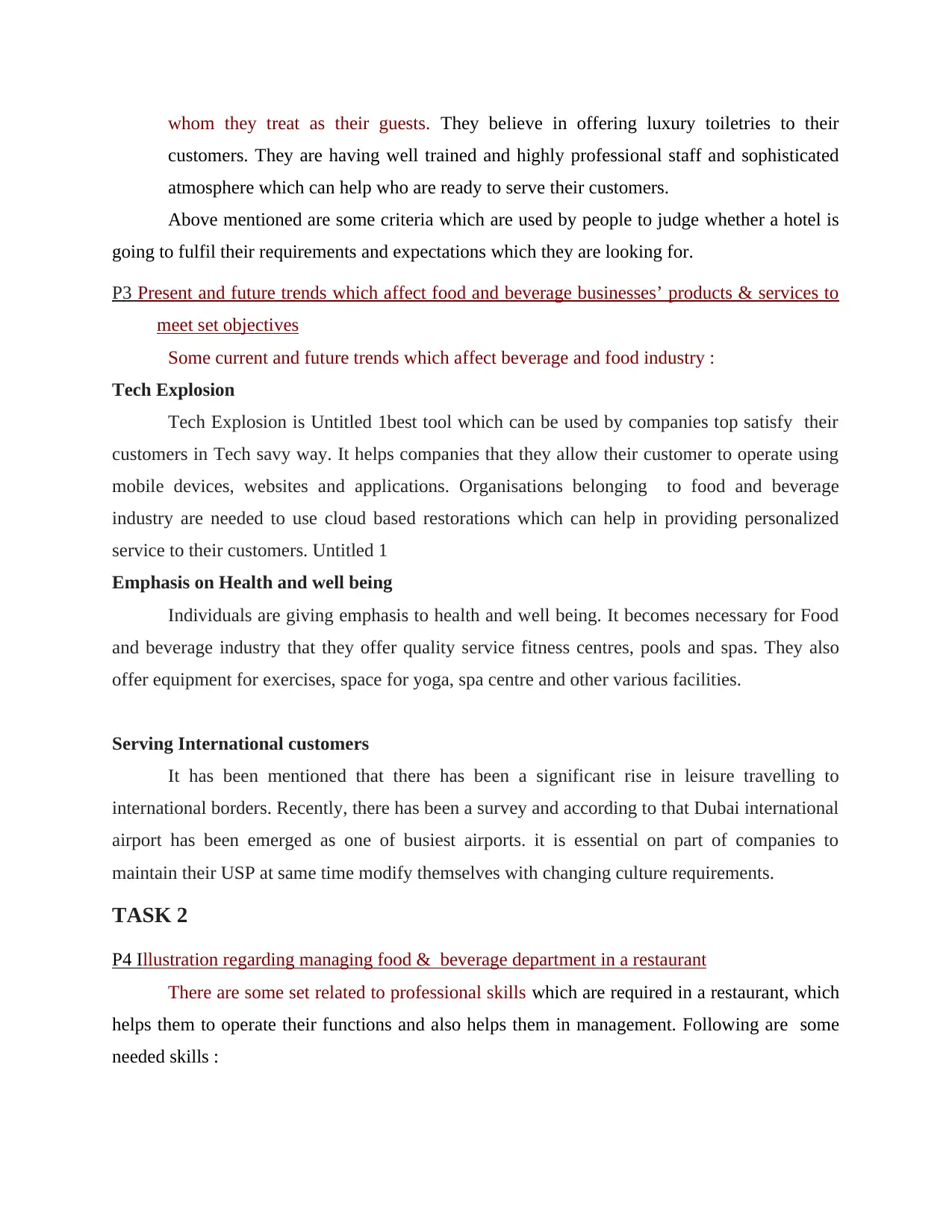
whom they treat as their guests. They believe in offering luxury toiletries to their
customers. They are having well trained and highly professional staff and sophisticated
atmosphere which can help who are ready to serve their customers.
Above mentioned are some criteria which are used by people to judge whether a hotel is
going to fulfil their requirements and expectations which they are looking for.
P3 Present and future trends which affect food and beverage businesses’ products & services to
meet set objectives
Some current and future trends which affect beverage and food industry :
Tech Explosion
Tech Explosion is Untitled 1best tool which can be used by companies top satisfy their
customers in Tech savy way. It helps companies that they allow their customer to operate using
mobile devices, websites and applications. Organisations belonging to food and beverage
industry are needed to use cloud based restorations which can help in providing personalized
service to their customers. Untitled 1
Emphasis on Health and well being
Individuals are giving emphasis to health and well being. It becomes necessary for Food
and beverage industry that they offer quality service fitness centres, pools and spas. They also
offer equipment for exercises, space for yoga, spa centre and other various facilities.
Serving International customers
It has been mentioned that there has been a significant rise in leisure travelling to
international borders. Recently, there has been a survey and according to that Dubai international
airport has been emerged as one of busiest airports. it is essential on part of companies to
maintain their USP at same time modify themselves with changing culture requirements.
TASK 2
P4 Illustration regarding managing food & beverage department in a restaurant
There are some set related to professional skills which are required in a restaurant, which
helps them to operate their functions and also helps them in management. Following are some
needed skills :
customers. They are having well trained and highly professional staff and sophisticated
atmosphere which can help who are ready to serve their customers.
Above mentioned are some criteria which are used by people to judge whether a hotel is
going to fulfil their requirements and expectations which they are looking for.
P3 Present and future trends which affect food and beverage businesses’ products & services to
meet set objectives
Some current and future trends which affect beverage and food industry :
Tech Explosion
Tech Explosion is Untitled 1best tool which can be used by companies top satisfy their
customers in Tech savy way. It helps companies that they allow their customer to operate using
mobile devices, websites and applications. Organisations belonging to food and beverage
industry are needed to use cloud based restorations which can help in providing personalized
service to their customers. Untitled 1
Emphasis on Health and well being
Individuals are giving emphasis to health and well being. It becomes necessary for Food
and beverage industry that they offer quality service fitness centres, pools and spas. They also
offer equipment for exercises, space for yoga, spa centre and other various facilities.
Serving International customers
It has been mentioned that there has been a significant rise in leisure travelling to
international borders. Recently, there has been a survey and according to that Dubai international
airport has been emerged as one of busiest airports. it is essential on part of companies to
maintain their USP at same time modify themselves with changing culture requirements.
TASK 2
P4 Illustration regarding managing food & beverage department in a restaurant
There are some set related to professional skills which are required in a restaurant, which
helps them to operate their functions and also helps them in management. Following are some
needed skills :
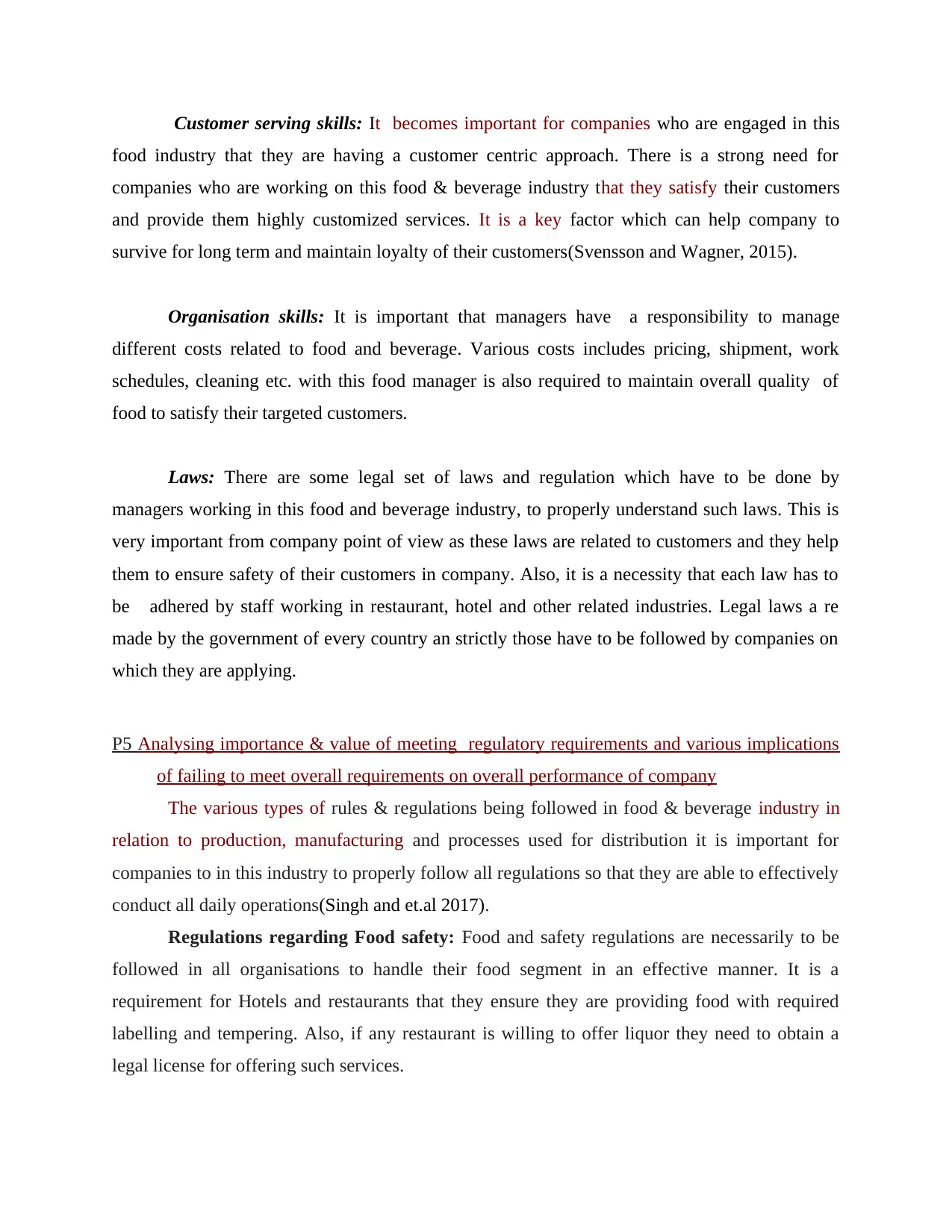
Customer serving skills: It becomes important for companies who are engaged in this
food industry that they are having a customer centric approach. There is a strong need for
companies who are working on this food & beverage industry that they satisfy their customers
and provide them highly customized services. It is a key factor which can help company to
survive for long term and maintain loyalty of their customers(Svensson and Wagner, 2015).
Organisation skills: It is important that managers have a responsibility to manage
different costs related to food and beverage. Various costs includes pricing, shipment, work
schedules, cleaning etc. with this food manager is also required to maintain overall quality of
food to satisfy their targeted customers.
Laws: There are some legal set of laws and regulation which have to be done by
managers working in this food and beverage industry, to properly understand such laws. This is
very important from company point of view as these laws are related to customers and they help
them to ensure safety of their customers in company. Also, it is a necessity that each law has to
be adhered by staff working in restaurant, hotel and other related industries. Legal laws a re
made by the government of every country an strictly those have to be followed by companies on
which they are applying.
P5 Analysing importance & value of meeting regulatory requirements and various implications
of failing to meet overall requirements on overall performance of company
The various types of rules & regulations being followed in food & beverage industry in
relation to production, manufacturing and processes used for distribution it is important for
companies to in this industry to properly follow all regulations so that they are able to effectively
conduct all daily operations(Singh and et.al 2017).
Regulations regarding Food safety: Food and safety regulations are necessarily to be
followed in all organisations to handle their food segment in an effective manner. It is a
requirement for Hotels and restaurants that they ensure they are providing food with required
labelling and tempering. Also, if any restaurant is willing to offer liquor they need to obtain a
legal license for offering such services.
food industry that they are having a customer centric approach. There is a strong need for
companies who are working on this food & beverage industry that they satisfy their customers
and provide them highly customized services. It is a key factor which can help company to
survive for long term and maintain loyalty of their customers(Svensson and Wagner, 2015).
Organisation skills: It is important that managers have a responsibility to manage
different costs related to food and beverage. Various costs includes pricing, shipment, work
schedules, cleaning etc. with this food manager is also required to maintain overall quality of
food to satisfy their targeted customers.
Laws: There are some legal set of laws and regulation which have to be done by
managers working in this food and beverage industry, to properly understand such laws. This is
very important from company point of view as these laws are related to customers and they help
them to ensure safety of their customers in company. Also, it is a necessity that each law has to
be adhered by staff working in restaurant, hotel and other related industries. Legal laws a re
made by the government of every country an strictly those have to be followed by companies on
which they are applying.
P5 Analysing importance & value of meeting regulatory requirements and various implications
of failing to meet overall requirements on overall performance of company
The various types of rules & regulations being followed in food & beverage industry in
relation to production, manufacturing and processes used for distribution it is important for
companies to in this industry to properly follow all regulations so that they are able to effectively
conduct all daily operations(Singh and et.al 2017).
Regulations regarding Food safety: Food and safety regulations are necessarily to be
followed in all organisations to handle their food segment in an effective manner. It is a
requirement for Hotels and restaurants that they ensure they are providing food with required
labelling and tempering. Also, if any restaurant is willing to offer liquor they need to obtain a
legal license for offering such services.
⊘ This is a preview!⊘
Do you want full access?
Subscribe today to unlock all pages.

Trusted by 1+ million students worldwide
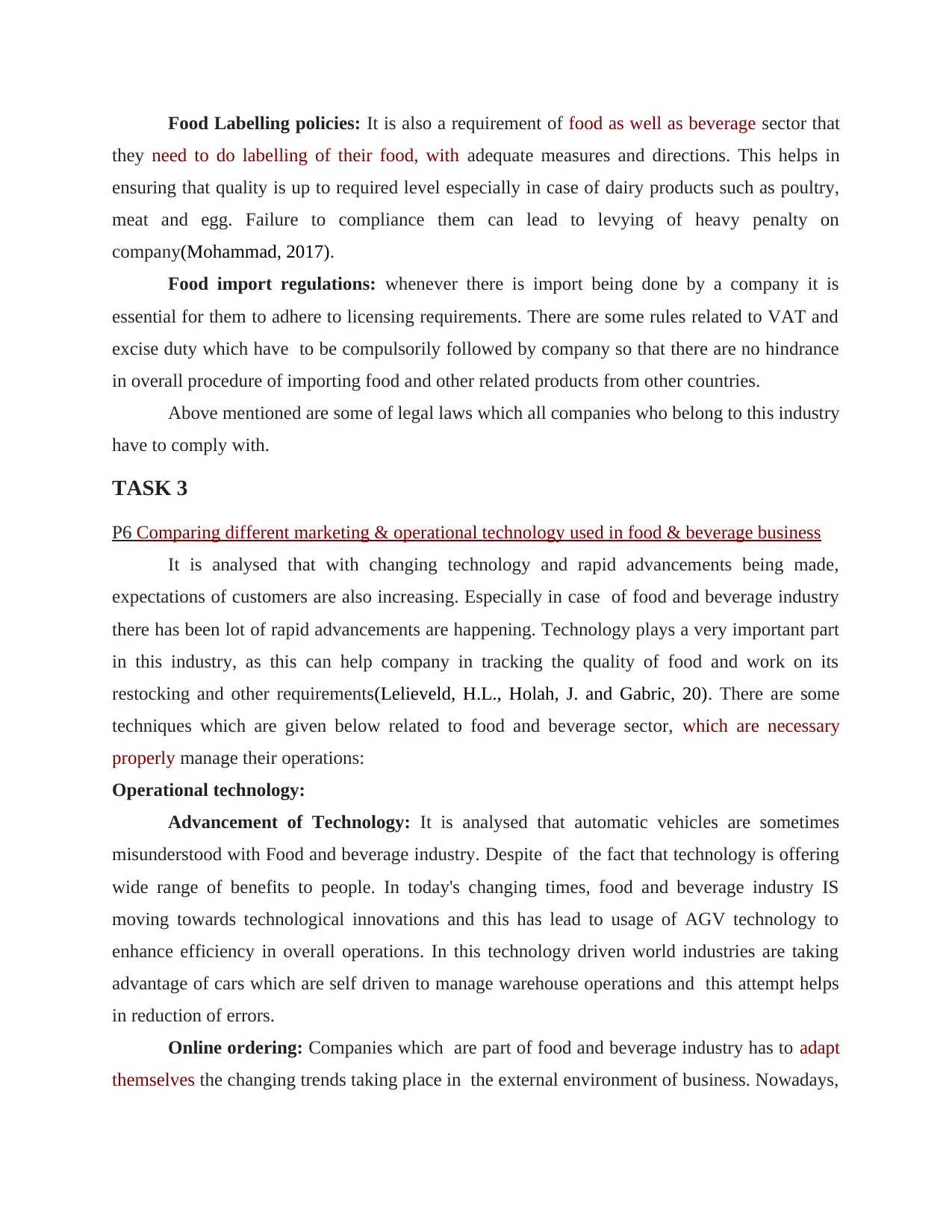
Food Labelling policies: It is also a requirement of food as well as beverage sector that
they need to do labelling of their food, with adequate measures and directions. This helps in
ensuring that quality is up to required level especially in case of dairy products such as poultry,
meat and egg. Failure to compliance them can lead to levying of heavy penalty on
company(Mohammad, 2017).
Food import regulations: whenever there is import being done by a company it is
essential for them to adhere to licensing requirements. There are some rules related to VAT and
excise duty which have to be compulsorily followed by company so that there are no hindrance
in overall procedure of importing food and other related products from other countries.
Above mentioned are some of legal laws which all companies who belong to this industry
have to comply with.
TASK 3
P6 Comparing different marketing & operational technology used in food & beverage business
It is analysed that with changing technology and rapid advancements being made,
expectations of customers are also increasing. Especially in case of food and beverage industry
there has been lot of rapid advancements are happening. Technology plays a very important part
in this industry, as this can help company in tracking the quality of food and work on its
restocking and other requirements(Lelieveld, H.L., Holah, J. and Gabric, 20). There are some
techniques which are given below related to food and beverage sector, which are necessary
properly manage their operations:
Operational technology:
Advancement of Technology: It is analysed that automatic vehicles are sometimes
misunderstood with Food and beverage industry. Despite of the fact that technology is offering
wide range of benefits to people. In today's changing times, food and beverage industry IS
moving towards technological innovations and this has lead to usage of AGV technology to
enhance efficiency in overall operations. In this technology driven world industries are taking
advantage of cars which are self driven to manage warehouse operations and this attempt helps
in reduction of errors.
Online ordering: Companies which are part of food and beverage industry has to adapt
themselves the changing trends taking place in the external environment of business. Nowadays,
they need to do labelling of their food, with adequate measures and directions. This helps in
ensuring that quality is up to required level especially in case of dairy products such as poultry,
meat and egg. Failure to compliance them can lead to levying of heavy penalty on
company(Mohammad, 2017).
Food import regulations: whenever there is import being done by a company it is
essential for them to adhere to licensing requirements. There are some rules related to VAT and
excise duty which have to be compulsorily followed by company so that there are no hindrance
in overall procedure of importing food and other related products from other countries.
Above mentioned are some of legal laws which all companies who belong to this industry
have to comply with.
TASK 3
P6 Comparing different marketing & operational technology used in food & beverage business
It is analysed that with changing technology and rapid advancements being made,
expectations of customers are also increasing. Especially in case of food and beverage industry
there has been lot of rapid advancements are happening. Technology plays a very important part
in this industry, as this can help company in tracking the quality of food and work on its
restocking and other requirements(Lelieveld, H.L., Holah, J. and Gabric, 20). There are some
techniques which are given below related to food and beverage sector, which are necessary
properly manage their operations:
Operational technology:
Advancement of Technology: It is analysed that automatic vehicles are sometimes
misunderstood with Food and beverage industry. Despite of the fact that technology is offering
wide range of benefits to people. In today's changing times, food and beverage industry IS
moving towards technological innovations and this has lead to usage of AGV technology to
enhance efficiency in overall operations. In this technology driven world industries are taking
advantage of cars which are self driven to manage warehouse operations and this attempt helps
in reduction of errors.
Online ordering: Companies which are part of food and beverage industry has to adapt
themselves the changing trends taking place in the external environment of business. Nowadays,
Paraphrase This Document
Need a fresh take? Get an instant paraphrase of this document with our AI Paraphraser
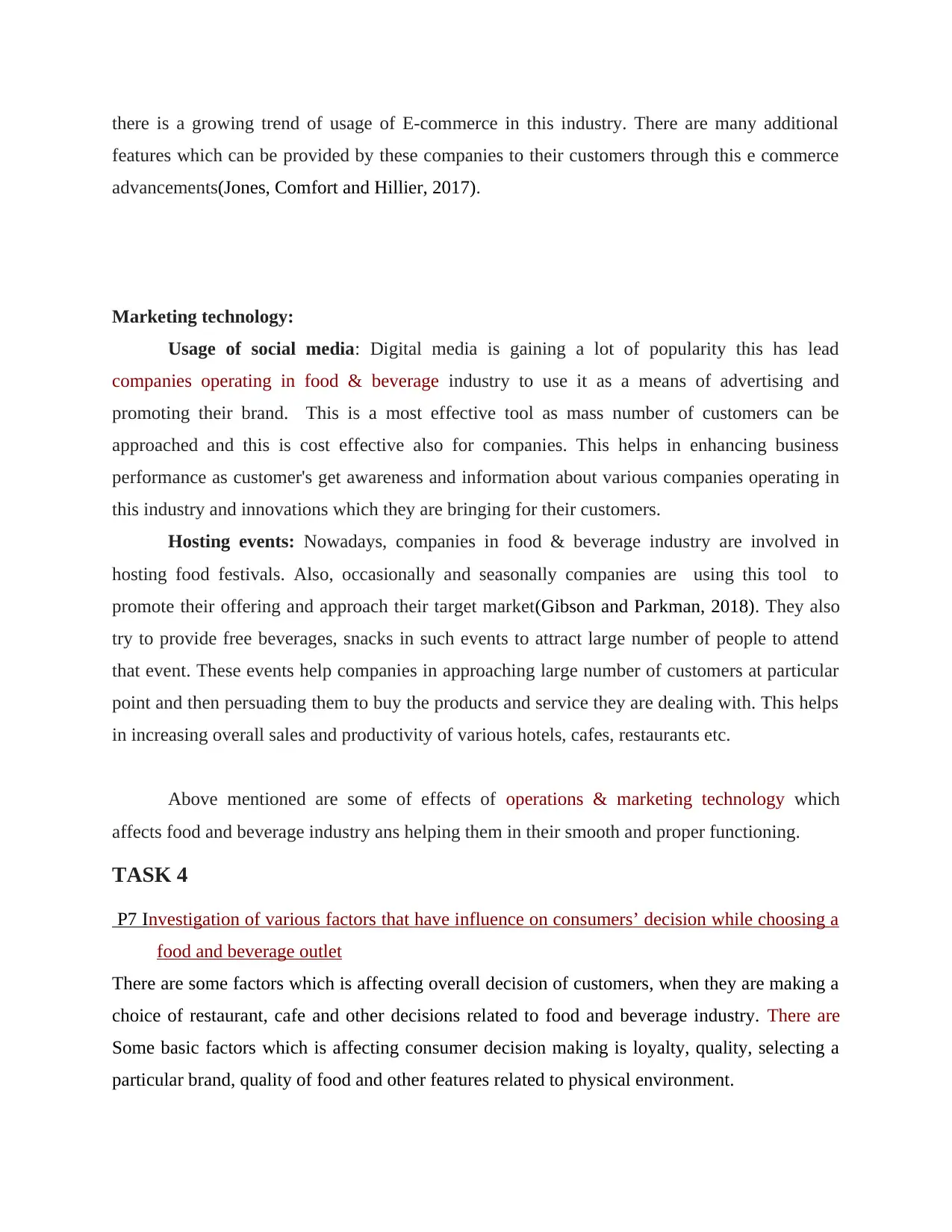
there is a growing trend of usage of E-commerce in this industry. There are many additional
features which can be provided by these companies to their customers through this e commerce
advancements(Jones, Comfort and Hillier, 2017).
Marketing technology:
Usage of social media: Digital media is gaining a lot of popularity this has lead
companies operating in food & beverage industry to use it as a means of advertising and
promoting their brand. This is a most effective tool as mass number of customers can be
approached and this is cost effective also for companies. This helps in enhancing business
performance as customer's get awareness and information about various companies operating in
this industry and innovations which they are bringing for their customers.
Hosting events: Nowadays, companies in food & beverage industry are involved in
hosting food festivals. Also, occasionally and seasonally companies are using this tool to
promote their offering and approach their target market(Gibson and Parkman, 2018). They also
try to provide free beverages, snacks in such events to attract large number of people to attend
that event. These events help companies in approaching large number of customers at particular
point and then persuading them to buy the products and service they are dealing with. This helps
in increasing overall sales and productivity of various hotels, cafes, restaurants etc.
Above mentioned are some of effects of operations & marketing technology which
affects food and beverage industry ans helping them in their smooth and proper functioning.
TASK 4
P7 Investigation of various factors that have influence on consumers’ decision while choosing a
food and beverage outlet
There are some factors which is affecting overall decision of customers, when they are making a
choice of restaurant, cafe and other decisions related to food and beverage industry. There are
Some basic factors which is affecting consumer decision making is loyalty, quality, selecting a
particular brand, quality of food and other features related to physical environment.
features which can be provided by these companies to their customers through this e commerce
advancements(Jones, Comfort and Hillier, 2017).
Marketing technology:
Usage of social media: Digital media is gaining a lot of popularity this has lead
companies operating in food & beverage industry to use it as a means of advertising and
promoting their brand. This is a most effective tool as mass number of customers can be
approached and this is cost effective also for companies. This helps in enhancing business
performance as customer's get awareness and information about various companies operating in
this industry and innovations which they are bringing for their customers.
Hosting events: Nowadays, companies in food & beverage industry are involved in
hosting food festivals. Also, occasionally and seasonally companies are using this tool to
promote their offering and approach their target market(Gibson and Parkman, 2018). They also
try to provide free beverages, snacks in such events to attract large number of people to attend
that event. These events help companies in approaching large number of customers at particular
point and then persuading them to buy the products and service they are dealing with. This helps
in increasing overall sales and productivity of various hotels, cafes, restaurants etc.
Above mentioned are some of effects of operations & marketing technology which
affects food and beverage industry ans helping them in their smooth and proper functioning.
TASK 4
P7 Investigation of various factors that have influence on consumers’ decision while choosing a
food and beverage outlet
There are some factors which is affecting overall decision of customers, when they are making a
choice of restaurant, cafe and other decisions related to food and beverage industry. There are
Some basic factors which is affecting consumer decision making is loyalty, quality, selecting a
particular brand, quality of food and other features related to physical environment.
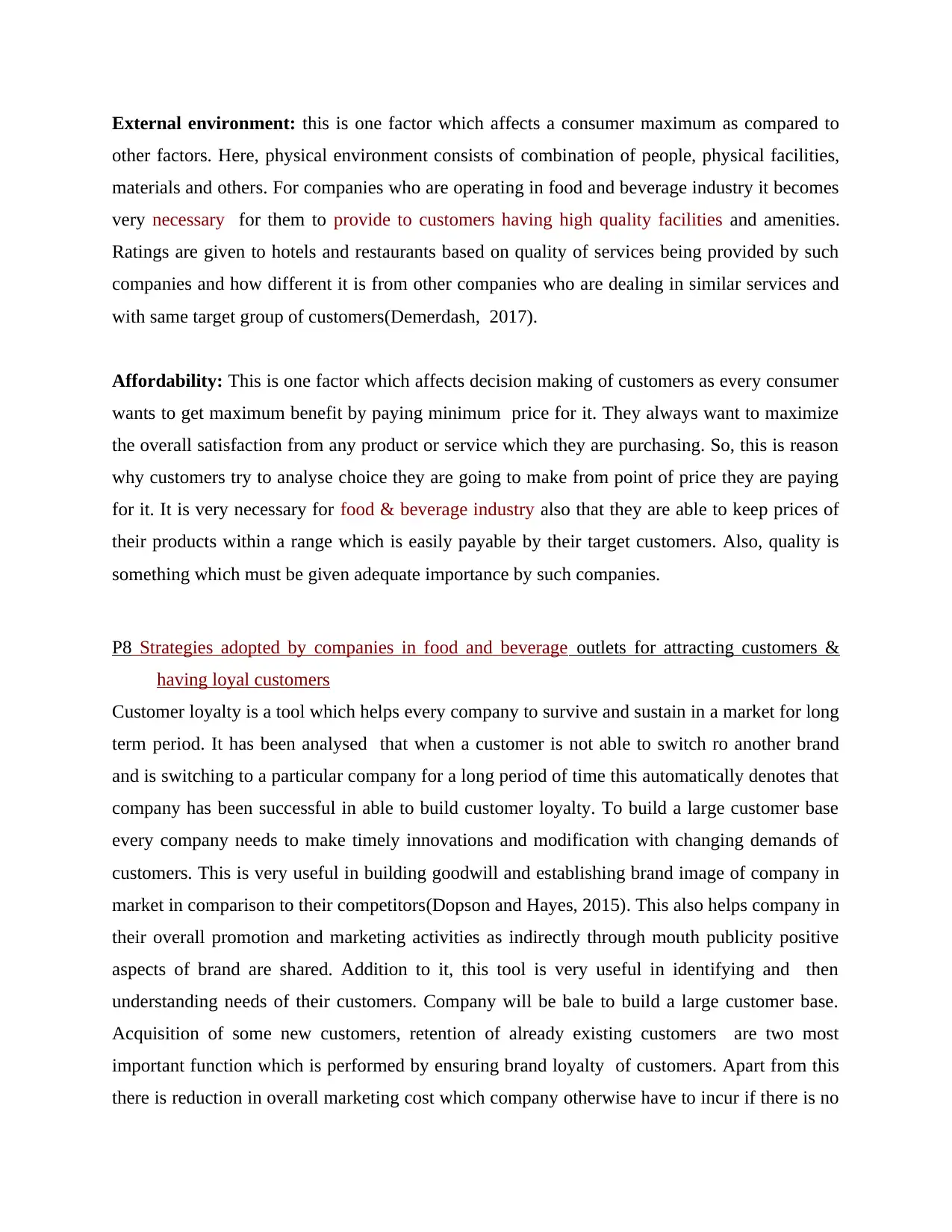
External environment: this is one factor which affects a consumer maximum as compared to
other factors. Here, physical environment consists of combination of people, physical facilities,
materials and others. For companies who are operating in food and beverage industry it becomes
very necessary for them to provide to customers having high quality facilities and amenities.
Ratings are given to hotels and restaurants based on quality of services being provided by such
companies and how different it is from other companies who are dealing in similar services and
with same target group of customers(Demerdash, 2017).
Affordability: This is one factor which affects decision making of customers as every consumer
wants to get maximum benefit by paying minimum price for it. They always want to maximize
the overall satisfaction from any product or service which they are purchasing. So, this is reason
why customers try to analyse choice they are going to make from point of price they are paying
for it. It is very necessary for food & beverage industry also that they are able to keep prices of
their products within a range which is easily payable by their target customers. Also, quality is
something which must be given adequate importance by such companies.
P8 Strategies adopted by companies in food and beverage outlets for attracting customers &
having loyal customers
Customer loyalty is a tool which helps every company to survive and sustain in a market for long
term period. It has been analysed that when a customer is not able to switch ro another brand
and is switching to a particular company for a long period of time this automatically denotes that
company has been successful in able to build customer loyalty. To build a large customer base
every company needs to make timely innovations and modification with changing demands of
customers. This is very useful in building goodwill and establishing brand image of company in
market in comparison to their competitors(Dopson and Hayes, 2015). This also helps company in
their overall promotion and marketing activities as indirectly through mouth publicity positive
aspects of brand are shared. Addition to it, this tool is very useful in identifying and then
understanding needs of their customers. Company will be bale to build a large customer base.
Acquisition of some new customers, retention of already existing customers are two most
important function which is performed by ensuring brand loyalty of customers. Apart from this
there is reduction in overall marketing cost which company otherwise have to incur if there is no
other factors. Here, physical environment consists of combination of people, physical facilities,
materials and others. For companies who are operating in food and beverage industry it becomes
very necessary for them to provide to customers having high quality facilities and amenities.
Ratings are given to hotels and restaurants based on quality of services being provided by such
companies and how different it is from other companies who are dealing in similar services and
with same target group of customers(Demerdash, 2017).
Affordability: This is one factor which affects decision making of customers as every consumer
wants to get maximum benefit by paying minimum price for it. They always want to maximize
the overall satisfaction from any product or service which they are purchasing. So, this is reason
why customers try to analyse choice they are going to make from point of price they are paying
for it. It is very necessary for food & beverage industry also that they are able to keep prices of
their products within a range which is easily payable by their target customers. Also, quality is
something which must be given adequate importance by such companies.
P8 Strategies adopted by companies in food and beverage outlets for attracting customers &
having loyal customers
Customer loyalty is a tool which helps every company to survive and sustain in a market for long
term period. It has been analysed that when a customer is not able to switch ro another brand
and is switching to a particular company for a long period of time this automatically denotes that
company has been successful in able to build customer loyalty. To build a large customer base
every company needs to make timely innovations and modification with changing demands of
customers. This is very useful in building goodwill and establishing brand image of company in
market in comparison to their competitors(Dopson and Hayes, 2015). This also helps company in
their overall promotion and marketing activities as indirectly through mouth publicity positive
aspects of brand are shared. Addition to it, this tool is very useful in identifying and then
understanding needs of their customers. Company will be bale to build a large customer base.
Acquisition of some new customers, retention of already existing customers are two most
important function which is performed by ensuring brand loyalty of customers. Apart from this
there is reduction in overall marketing cost which company otherwise have to incur if there is no
⊘ This is a preview!⊘
Do you want full access?
Subscribe today to unlock all pages.

Trusted by 1+ million students worldwide
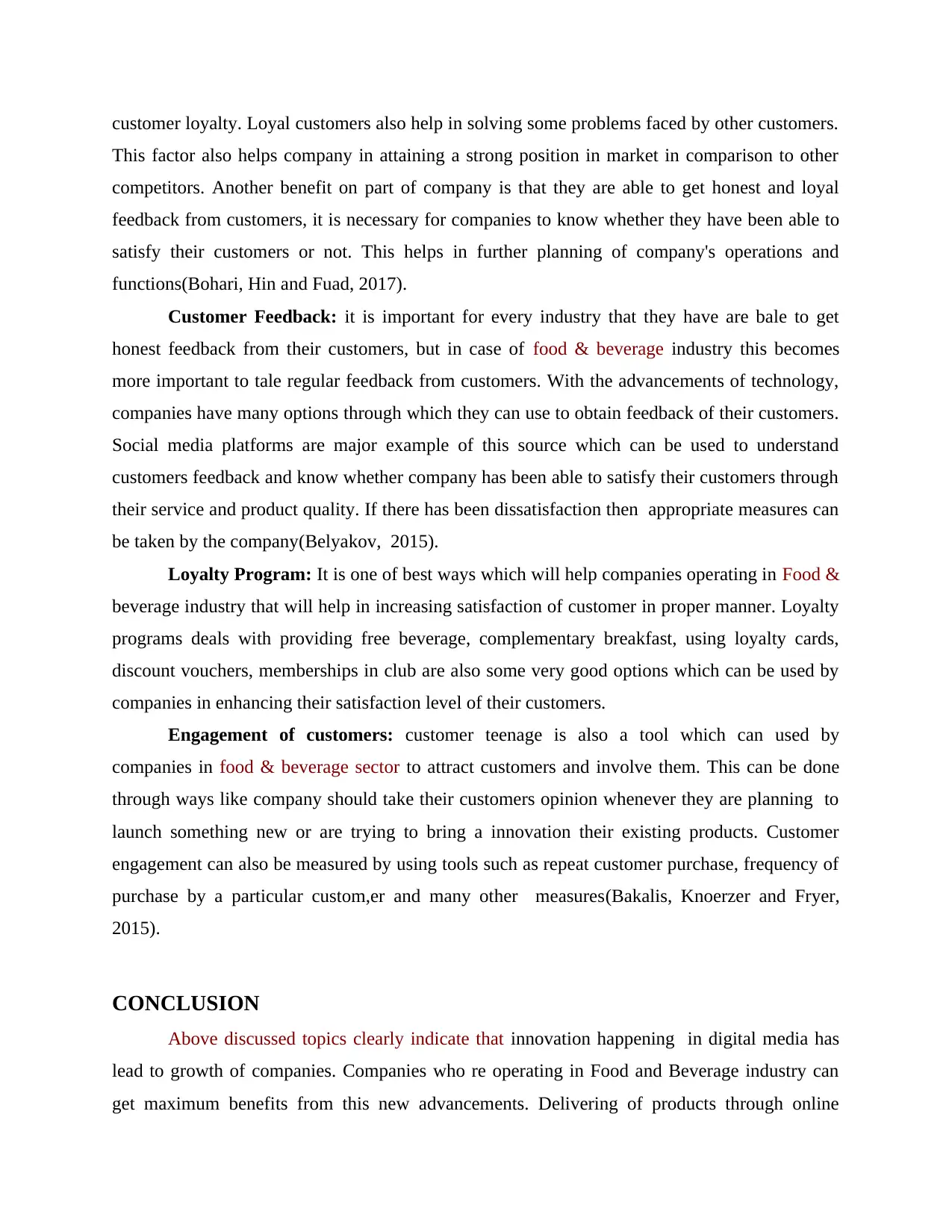
customer loyalty. Loyal customers also help in solving some problems faced by other customers.
This factor also helps company in attaining a strong position in market in comparison to other
competitors. Another benefit on part of company is that they are able to get honest and loyal
feedback from customers, it is necessary for companies to know whether they have been able to
satisfy their customers or not. This helps in further planning of company's operations and
functions(Bohari, Hin and Fuad, 2017).
Customer Feedback: it is important for every industry that they have are bale to get
honest feedback from their customers, but in case of food & beverage industry this becomes
more important to tale regular feedback from customers. With the advancements of technology,
companies have many options through which they can use to obtain feedback of their customers.
Social media platforms are major example of this source which can be used to understand
customers feedback and know whether company has been able to satisfy their customers through
their service and product quality. If there has been dissatisfaction then appropriate measures can
be taken by the company(Belyakov, 2015).
Loyalty Program: It is one of best ways which will help companies operating in Food &
beverage industry that will help in increasing satisfaction of customer in proper manner. Loyalty
programs deals with providing free beverage, complementary breakfast, using loyalty cards,
discount vouchers, memberships in club are also some very good options which can be used by
companies in enhancing their satisfaction level of their customers.
Engagement of customers: customer teenage is also a tool which can used by
companies in food & beverage sector to attract customers and involve them. This can be done
through ways like company should take their customers opinion whenever they are planning to
launch something new or are trying to bring a innovation their existing products. Customer
engagement can also be measured by using tools such as repeat customer purchase, frequency of
purchase by a particular custom,er and many other measures(Bakalis, Knoerzer and Fryer,
2015).
CONCLUSION
Above discussed topics clearly indicate that innovation happening in digital media has
lead to growth of companies. Companies who re operating in Food and Beverage industry can
get maximum benefits from this new advancements. Delivering of products through online
This factor also helps company in attaining a strong position in market in comparison to other
competitors. Another benefit on part of company is that they are able to get honest and loyal
feedback from customers, it is necessary for companies to know whether they have been able to
satisfy their customers or not. This helps in further planning of company's operations and
functions(Bohari, Hin and Fuad, 2017).
Customer Feedback: it is important for every industry that they have are bale to get
honest feedback from their customers, but in case of food & beverage industry this becomes
more important to tale regular feedback from customers. With the advancements of technology,
companies have many options through which they can use to obtain feedback of their customers.
Social media platforms are major example of this source which can be used to understand
customers feedback and know whether company has been able to satisfy their customers through
their service and product quality. If there has been dissatisfaction then appropriate measures can
be taken by the company(Belyakov, 2015).
Loyalty Program: It is one of best ways which will help companies operating in Food &
beverage industry that will help in increasing satisfaction of customer in proper manner. Loyalty
programs deals with providing free beverage, complementary breakfast, using loyalty cards,
discount vouchers, memberships in club are also some very good options which can be used by
companies in enhancing their satisfaction level of their customers.
Engagement of customers: customer teenage is also a tool which can used by
companies in food & beverage sector to attract customers and involve them. This can be done
through ways like company should take their customers opinion whenever they are planning to
launch something new or are trying to bring a innovation their existing products. Customer
engagement can also be measured by using tools such as repeat customer purchase, frequency of
purchase by a particular custom,er and many other measures(Bakalis, Knoerzer and Fryer,
2015).
CONCLUSION
Above discussed topics clearly indicate that innovation happening in digital media has
lead to growth of companies. Companies who re operating in Food and Beverage industry can
get maximum benefits from this new advancements. Delivering of products through online
Paraphrase This Document
Need a fresh take? Get an instant paraphrase of this document with our AI Paraphraser

mode, orders placed using online available applications, tracking of orders are some features
which has lead to growth of this industry. Understanding of consumer behaviour can also be
done through these technological measures. With changing trends companies have realised that
they can obtain a distinctive position in market only when they are able to provide some
innovation in their products or services.
which has lead to growth of this industry. Understanding of consumer behaviour can also be
done through these technological measures. With changing trends companies have realised that
they can obtain a distinctive position in market only when they are able to provide some
innovation in their products or services.
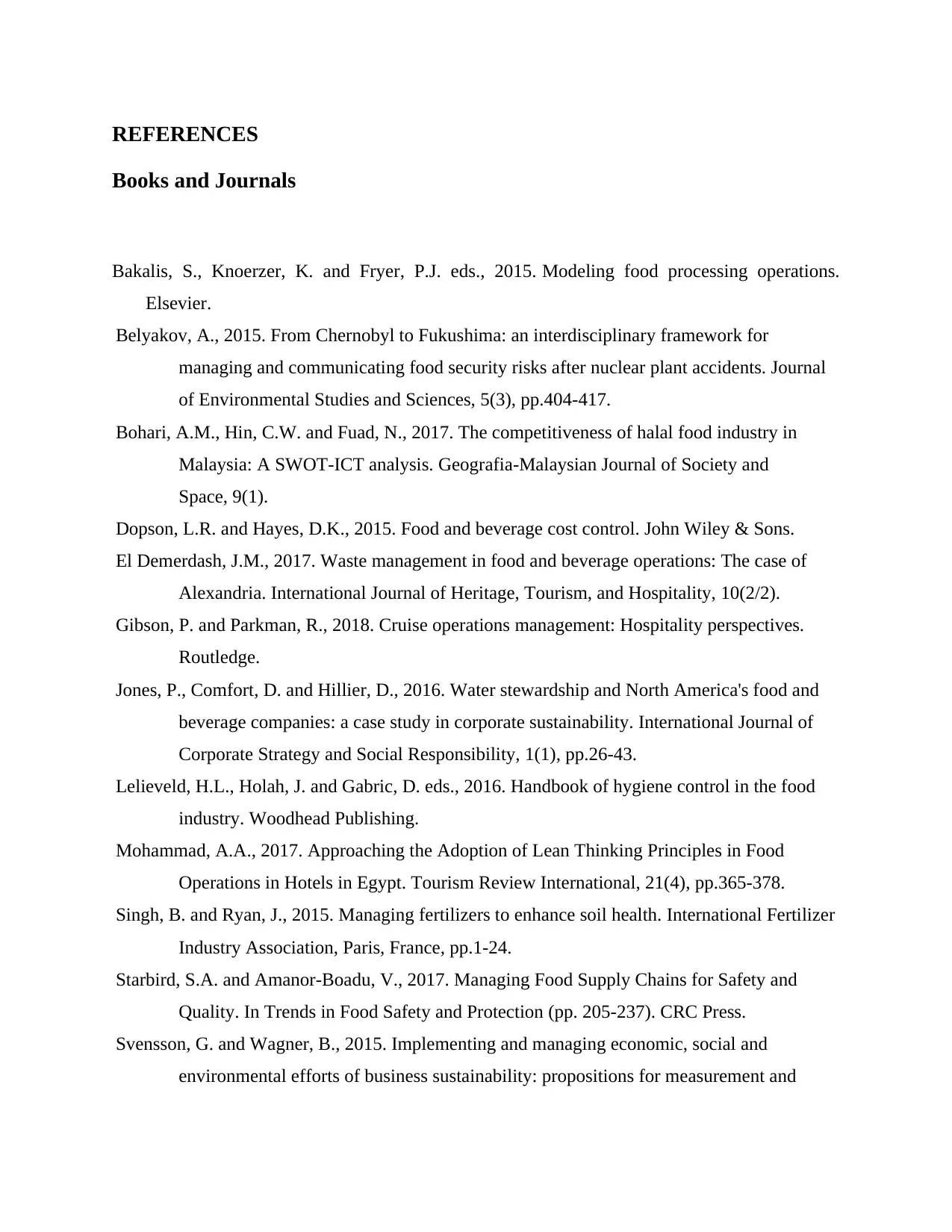
REFERENCES
Books and Journals
Bakalis, S., Knoerzer, K. and Fryer, P.J. eds., 2015. Modeling food processing operations.
Elsevier.
Belyakov, A., 2015. From Chernobyl to Fukushima: an interdisciplinary framework for
managing and communicating food security risks after nuclear plant accidents. Journal
of Environmental Studies and Sciences, 5(3), pp.404-417.
Bohari, A.M., Hin, C.W. and Fuad, N., 2017. The competitiveness of halal food industry in
Malaysia: A SWOT-ICT analysis. Geografia-Malaysian Journal of Society and
Space, 9(1).
Dopson, L.R. and Hayes, D.K., 2015. Food and beverage cost control. John Wiley & Sons.
El Demerdash, J.M., 2017. Waste management in food and beverage operations: The case of
Alexandria. International Journal of Heritage, Tourism, and Hospitality, 10(2/2).
Gibson, P. and Parkman, R., 2018. Cruise operations management: Hospitality perspectives.
Routledge.
Jones, P., Comfort, D. and Hillier, D., 2016. Water stewardship and North America's food and
beverage companies: a case study in corporate sustainability. International Journal of
Corporate Strategy and Social Responsibility, 1(1), pp.26-43.
Lelieveld, H.L., Holah, J. and Gabric, D. eds., 2016. Handbook of hygiene control in the food
industry. Woodhead Publishing.
Mohammad, A.A., 2017. Approaching the Adoption of Lean Thinking Principles in Food
Operations in Hotels in Egypt. Tourism Review International, 21(4), pp.365-378.
Singh, B. and Ryan, J., 2015. Managing fertilizers to enhance soil health. International Fertilizer
Industry Association, Paris, France, pp.1-24.
Starbird, S.A. and Amanor-Boadu, V., 2017. Managing Food Supply Chains for Safety and
Quality. In Trends in Food Safety and Protection (pp. 205-237). CRC Press.
Svensson, G. and Wagner, B., 2015. Implementing and managing economic, social and
environmental efforts of business sustainability: propositions for measurement and
Books and Journals
Bakalis, S., Knoerzer, K. and Fryer, P.J. eds., 2015. Modeling food processing operations.
Elsevier.
Belyakov, A., 2015. From Chernobyl to Fukushima: an interdisciplinary framework for
managing and communicating food security risks after nuclear plant accidents. Journal
of Environmental Studies and Sciences, 5(3), pp.404-417.
Bohari, A.M., Hin, C.W. and Fuad, N., 2017. The competitiveness of halal food industry in
Malaysia: A SWOT-ICT analysis. Geografia-Malaysian Journal of Society and
Space, 9(1).
Dopson, L.R. and Hayes, D.K., 2015. Food and beverage cost control. John Wiley & Sons.
El Demerdash, J.M., 2017. Waste management in food and beverage operations: The case of
Alexandria. International Journal of Heritage, Tourism, and Hospitality, 10(2/2).
Gibson, P. and Parkman, R., 2018. Cruise operations management: Hospitality perspectives.
Routledge.
Jones, P., Comfort, D. and Hillier, D., 2016. Water stewardship and North America's food and
beverage companies: a case study in corporate sustainability. International Journal of
Corporate Strategy and Social Responsibility, 1(1), pp.26-43.
Lelieveld, H.L., Holah, J. and Gabric, D. eds., 2016. Handbook of hygiene control in the food
industry. Woodhead Publishing.
Mohammad, A.A., 2017. Approaching the Adoption of Lean Thinking Principles in Food
Operations in Hotels in Egypt. Tourism Review International, 21(4), pp.365-378.
Singh, B. and Ryan, J., 2015. Managing fertilizers to enhance soil health. International Fertilizer
Industry Association, Paris, France, pp.1-24.
Starbird, S.A. and Amanor-Boadu, V., 2017. Managing Food Supply Chains for Safety and
Quality. In Trends in Food Safety and Protection (pp. 205-237). CRC Press.
Svensson, G. and Wagner, B., 2015. Implementing and managing economic, social and
environmental efforts of business sustainability: propositions for measurement and
⊘ This is a preview!⊘
Do you want full access?
Subscribe today to unlock all pages.

Trusted by 1+ million students worldwide
1 out of 13
Related Documents
Your All-in-One AI-Powered Toolkit for Academic Success.
+13062052269
info@desklib.com
Available 24*7 on WhatsApp / Email
![[object Object]](/_next/static/media/star-bottom.7253800d.svg)
Unlock your academic potential
Copyright © 2020–2025 A2Z Services. All Rights Reserved. Developed and managed by ZUCOL.




